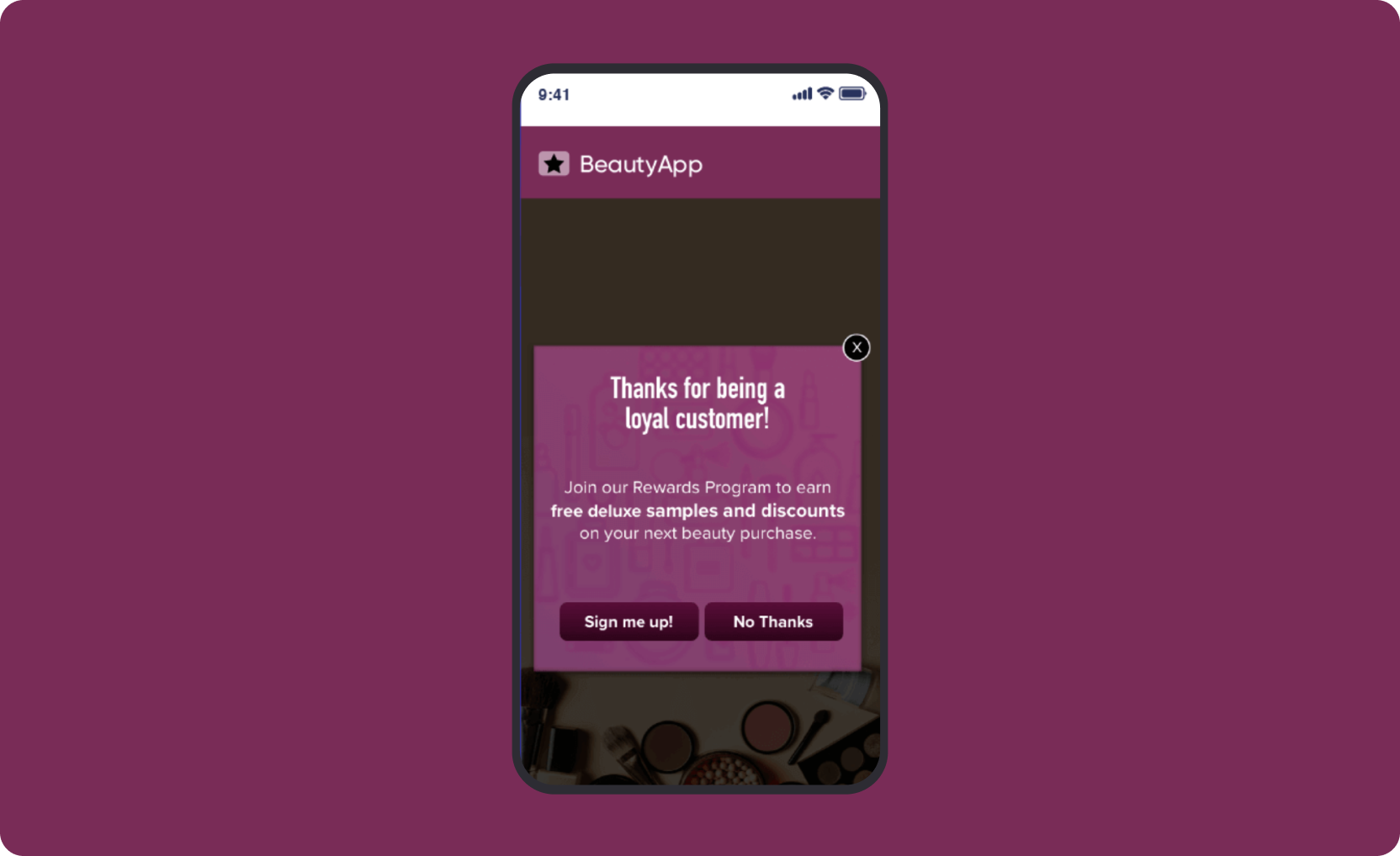9 reasons in-app messaging is better than SMS and email

Taking customer communication to the next level with in-app messaging
Modern businesses have many options when it comes to communicating with customers. For appointment reminders, order updates, travel alerts, sales announcements, and other common use cases, most businesses use some form of mobile-specific communication, such as in-app messaging, chat, or calls, to reach customers.
SMS is a popular way to communicate with customers. Although SMS has a jaw-dropping open rate of 98%, it is not targeted or contextualized. In this blog, we’ll look at the details of why SMS is not the best option for customer communications in today’s hyper-personalized world. Then, we’ll talk about why in-app messaging is the way to go and nine important benefits. Finally, we’ll suggest five in-app messaging best practices!
So why is SMS not a viable option for customer communication today?
The problems with SMS, a predecessor of in-app messaging
SMS is a popular option for product managers and marketers seeking to reach customers on their mobile devices. This is largely due to the fact that these messages are received in the single most relevant place when it comes to customers: their phones. Consider these stats:
97% of Americans own at least one cell phone.
Cell phone users spend about 5 hours a day on their phones.
90% of the time on phones focuses on apps and social media.
While many of us enjoy aimlessly surfing the internet on our phones, it’s clear that the majority of the time people spend on their phones is dedicated to connecting with brands and people. This ensures that customers are a captive audience when you reach out to them via SMS, meaning you’ll almost always see higher and faster response rates.
However, as more brands lean into SMS, an oversaturation is taking place. With nearly 560 billion texts being sent monthly worldwide, it’s hard to stand out. To put that in perspective, in just the time it has taken you to read this much of our article, more than 15 million texts were likely sent out globally.
Furthermore, SMS can be construed as spam, eroding customer trust. Another aspect to think about is that your brand doesn’t own the data when it’s sent through SMS. This means that you can’t gather insights to fuel growth.
A peek into the past: Where did the need for in-app messaging come from?
SMS and push notifications weren’t possible until recent years. For example, imagine that you owned a company in the 1980s that manufactured outboard motors for boats. As with most brands at that time, your main method for messaging to customers was through television, magazine, and newspaper ads. While these ads were well-designed, they almost never appeared to customers when they were engaging with your brand.
To accomplish that feat, you’d need to contact a customer while they were in their boat. Let’s say they were fueling their outboard motor in preparation for a day on the lake, and you were somehow able to hand them a personalized note explaining how you could help them get better performance from their motor.
This scenario might have seemed fantastical (and a bit creepy) in 1987, but today it’s completely possible - and effective - thanks to real-time channels such as in-app messaging. There’s still a time and place for effective SMS messages, but in-app messaging provides a more flexible, cost-efficient, and scalable way to reach your audience.
In-app messaging: The proven SMS alternative
Given the large number of business communications that customers see on a daily basis, your messages will only be impactful if they offer benefits or solutions that customers are looking for. Relevancy is now the currency upon which all your channels thrive. If you can answer a question, solve a challenge, or provide a delightful experience, you’ll see incredible levels of in-app engagement.
Fail to include any of these factors and your message will join the junk heap of business messages that builds up in our lives each day.
When it comes to relevancy, in-app messages give you a massive advantage. Your audience has already chosen to spend time with your brand, and because they’re in your app, you know what they’re up to. Tailoring a message to their actions and needs is easier than ever.
Returning to our example of a decades-old boat motor company, a modern version of that same company could achieve great results using in-app messaging. If a customer were about to purchase a new motor, you could send an in-app message suggesting a key accessory that will help the customer get maximum performance from the new motor.
Another opportunity for relevant messaging might be if the customer exited your brand’s checkout page without making a purchase. You could send a personalized in-app message alerting them that they haven’t yet completed the transaction. And, if you’re feeling generous, you could offer them a one-time discount!

Adapted from source.
It’s this timeliness and relevance in your app that makes in-app messaging so successful in customer communication. While these other types of communications can be highly effective, they aren’t as targeted because you don’t necessarily know what the customer is doing when you send them.
Based on a customer’s app activities, you’ll be able to customize messages that will be triggered by various actions. You can:
Provide onboarding tips to new app users
Share specialized product insights after a purchase is made
Send exclusive discounts to your app users
Deliver status updates on an order or customer service request
Send an enticing CTA when the user appears ready to leave the app
Thanks to access to crucial data, you’ll be able to tailor your messages and engage customers in better ways.

Elevate in-app engagement eBook
9 undeniable benefits of in-app messaging
Let’s review nine ways that in-app messaging can provide results for your business. Some are small perks and others are legitimate game-changers, and they all add up to a better customer experience!
1. The timing is impeccable
Thanks to programmed triggers, you can send the ideal message to customers at just the right time. This enhanced context ensures better in-app engagement and results.
2. Higher level of personalization
Related to the timing element is the fact that in-app messages are personalized to the hilt. You can target them based on factors such as location, behavior, and preferences.
3. Independent of other platforms
While popular social messaging options like Facebook Messenger or WhatsApp require third-party accounts, in-app messaging provides a direct link to your customers in a fully native, branded experience.
4. Maintains brand integrity
Third-party messaging channels also reduce control of your branding, as you’re often forced to use their templates and adhere to their limitations. Rather than trying to shoehorn your brand into another platform, in-app messaging keeps everything in-house. You can be confident in how your messages look and sound.
5. Simple to create
In-app messages are among the easiest communications that a business can put together. This accessibility enables you to be nimble in your messages and always have the bandwidth to refine what you’re trying to say.
6. The cost is lower than third-party channels
Along with the simplicity of in-app messages comes cost savings. You’ll invest less time and resources in these messages, which frees up money to be put to use in enhancing other aspects of the user experience.
7. Boosts your app’s stickiness
When users can accomplish more things and stay better connected within your app, they’re more likely to use it. Effectively using in-app messaging increases the number of people accessing your app and the time they spend within it.
8. Provides a more integrated experience
It’s a timeless truth that the more steps a user is required to take, the more use churn will take place. You can help reduce unnecessary hurdles by messaging within your app. Customers will already have identified themselves prior to using the app, so you’ll be able to get right to the heart of the matter with them and not waste time with redundant protocols.
9. Better access to data
Continuous improvement is key to staying competitive in today’s world, so you’ll be happy to hear that in-app messaging makes it easy to track the performance of your efforts. Bolstered by readily available metrics and analytics, you’ll be able to make faster refinements.
5 in-app messaging best practices
If you aren’t currently using in-app messaging, you’re missing out on an essential opportunity to build your brand and develop customer loyalty. And even if you’re already using in-app messaging, there are always opportunities to get better!
With so much talk about the simplicity and convenience of in-app messaging, it’s possible to lose track of the fact that there’s still a lot of strategy required for success. Yes, there are ample benefits available. But you’ll never capture them if you put your communications on autopilot.
Here are five best practices to keep your in-app messaging on target
1. Create meaningful conversations
The beauty of in-app messages is that they can deliver quick tips or updates, then seamlessly segue into conversations whenever necessary. Start with brevity and then be ready for deeper chats when that’s what the customer needs.
2. Add personalization whenever possible
Your messages are already going to be relevant to customers reading them, but they’ll take on an added impact when you include details such as the user’s name and targeted copy based on where they are in the customer journey.
3. Include visual elements
If a photo or video will improve a message, never hesitate to add one. At a minimum, consider using emojis that bring personality to your communications.
4. Make your CTA crystal clear
At the heart of every message should be a call to action that benefits the user. You’ve already achieved in-app engagement, so never leave them wondering what to do next!
5. Double-check each message
Even when you’re rushing to get a timely message out to your users, make sure that multiple people have reviewed it. You’ll find that the extra 30 minutes it might take to get another pair of eyes on a message are worthwhile, as even small errors make your brand look bad and erode customer trust.
Start to send meaningful in-app messaging today
It’s important to partner with the right service provider to get the best reliability and efficiency when building your communications capabilities. Sendbird has extensive experience with in-app messaging, and our robust communications API platform can help you achieve the best conversion and retention rates.
Ready to see what Sendbird’s industry-leading products can do for your business? Simply sign up for a free account or talk to us to get started today. You’ll find all the tools and resources needed to deliver relevant in-app messages and keep your app experience top-notch.










